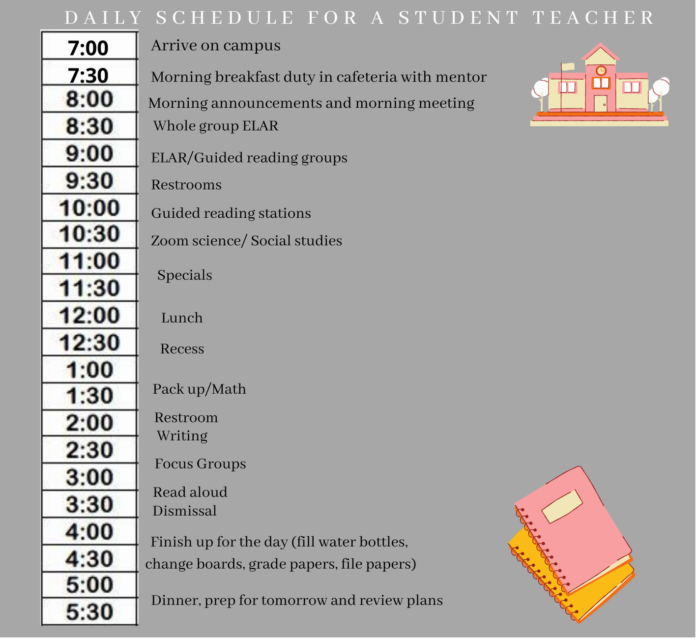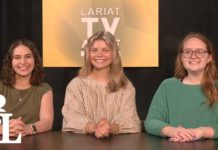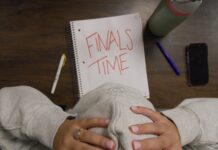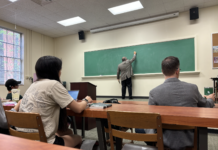
By Meredith Pratt | Staff Writer
With the ongoing COVID-19 pandemic, juniors and seniors in the Baylor School of Education have navigated student teaching in an unfamiliar set of circumstances.
Senior student teachers work full-time Monday through Thursday in a K12 classroom for two semesters, while junior teaching assistants usually spend one or two semesters leading small groups four mornings a week in local schools.
This fall, planning student-teaching experiences with local partner schools began early. Baylor student teachers had to adhere to requirements from the Texas Education Agency and were prepared to teach whatever format their mentor teachers were tasked with. Some taught face-to-face on a school campus, while others worked remotely from the school or a separate location. Some had a combination of both in-person and online.
“Flexibility has always been the name of the game in teaching,” Dr. Neil Shanks, assistant clinical professor of middle and secondary education said. “I can’t say enough about how hard our Baylor students have worked, how challenging it has been and how positive their attitudes have been.”
Shanks, who also serves as one of the supervisors for the Baylor teaching interns, said he has seen the student teachers rise to the occasion during the pandemic.
“All teachers are in such difficult circumstances and being asked to do so much,” Shanks said. “The interns are proving to be very valuable to schools.”
Plano senior Brittany Griffith is one of those interns. She taught 14 to 16 in-person students at Hillcrest PDS elementary this semester and said her role as a teacher is to keep an uplifting and encouraging “we can do this” spirit.
“I’ve been working in a third-grade classroom, and not only were my students challenged with losing the last few months of their second-grade experience, but some of our students lacked a proper second grade curriculum to begin with,” Griffith said. “Every morning, I walked into my classroom knowing I needed to have grace on my heart for each of my students.”
Griffith said one of her favorite parts of the student-teaching experience has been getting to know her individual students.
“Something I’ve found that really helps to make deeper connections with my students is to take a few minutes each morning to talk about their weekend or their evening before,” Griffith said. “My students open up about celebrations, COVID frustrations and their newest video game obsessions.”
Houston senior Vanessa Jessurun is another intern at Hillcrest PDS who taught second grade face-to-face and online. This hybrid situation included teaching all subjects to the 16 in-person students and teaching social studies and science to the 20 other students on Zoom.
“It was definitely a challenge teaching social studies and science to both classes simultaneously,” Jessurun said. “The main obstacle was ensuring I was giving all the students the same amount of attention and care.”
Echoing Shanks, Jessurun said this semester highlighted the “importance of flexibility” as an educator. Some of these moments she encountered included technology failures during lessons, students’ absences during important district exams and having to move multiple students online due to a quarantine case.
A normal day for Jessurun begins at 5:45 a.m. She said she gets ready, eats breakfast and packs her lunch, then leaves her apartment by 7:10 a.m. Upon arrival at Hillcrest, she walks in the back door of the school where she is greeted by her intern supervisor and the school staff. She shows them her WISD COVID-19 check confirmation survey, and they check her temperature and give her a sticker proving she had been checked.
Once she has signed in and writes down her temperature, she heads to her classroom to set up her materials and prepare for the day. At 7:45 a.m., she goes to the lunchroom to help with breakfast duty.
“As the students trickle into the cafeteria they are given free breakfast if they hadn’t eaten,” Jessurun said. “While we wait for the rest of the class to come in, I talk to the students while they are eating or waiting. I love communicating and building relationships with my students during this time. I learn so much about them, and I try and get them excited about their day.”
The remainder of the day includes morning meetings, English stations, Zoom social studies or science class, P.E. or music class, grading papers, lunch, recess, math, writing and iPad time.
Just before dismissal at 3:20 p.m., Jessurun reads a Magic Treehouse book to the students. After the students leave, she finishes grading and filing papers and preparing for the next day.
“I typically leave campus at about 5:30 p.m.,” Jessurun said. “Once I get home, I shower, eat dinner, write my lesson reflections, then prepare and review my lessons for the next day.”
“Rewarding” is the first word that comes to mind when thinking about her student-teaching experience this semester, Jessurun said. While she admits teaching is “hard work” and has been “even more challenging during these pandemic times,” Jessurun said each day she left school feeling grateful and accomplished.
“This semester has shown me that this career path is definitely worth it. It is such a unique blessing we as seniors have to experience a full-time job of teaching,” Jessurun said. “It has been eye-opening to encounter the realities of the teaching profession before I have my own classroom.”





